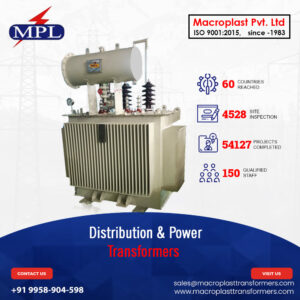The role of transformers is to change the voltage to meet the requirements of different functions within the electrical system. Transformers have two main types: power transformers and distribution transformers. Features of these two different machines keep them different from each other.
What is a Power Transformer: Power transformers are used for heavy loads. They are perfect for loads greater than 33 KV & 100% efficient. They are bigger in size than their distribution counterparts. They are used to generate station and Transmission substations, with high insulation levels. They have a higher MVA rating than distribution transformers.

What is a Distribution Transformer?: Distribution transformers are smaller than power transformers and are used for circulating current. Mainly used in electricity distribution networks, they step down the voltages that need to be supplied to customers. They are ideally used underground or on poles. They are good for both domestic consumers and industrial purposes.

Difference between a power transformer and a distribution transformer
- Usage Difference: Used to generate station and substation to step up low voltage level to the higher one, transmitting network with significantly higher voltage. Distribution transformers step-down higher voltage levels to the lower ones, and distribute electric power to the consumer units. They function in distributing networks defined by lower voltages.
- Rating Difference: Power transformers come in different ratings, such as 200kV, 400kV, 66kV, and 33kV. Distribution transformers ratings include 3.3kV, 11kV, 6.6kV, 230 volts and 440v.
- Operational Difference: Power transformers are designed to function on full load rating i.e. they operate at full load with minimal load fluctuations and are analyzed by commercial or maximum efficiency. Distribution transformers operate at a light load during major parts of the day.
- Power Rating Differences: MVA i.e. Mega Volt-Amp is a unit of Apparent power. It is a very large unit of VA. The power rating of power transformers is more than 300 MVA whereas it is less than 200 MVA in distribution transformers.
- Efficiency Differences: While power transformers have 100% efficiency, using the ratio of power output/input, distribution transformers’ efficiency varies between 50%-70%, and is calculated based on All Day Efficiency.
- Size Difference: Power transformers are larger in size in comparison to their distribution transformers.
- Metal Losses: Metal losses are very less because they don’t have direct contact with customers. Distribution transformers are very high because of load differences and end-user connectivity.
These are the common differences between power transformers and distribution transformers. Based on the information, you can have an informed decision now in choosing Macroplast Transformers.



